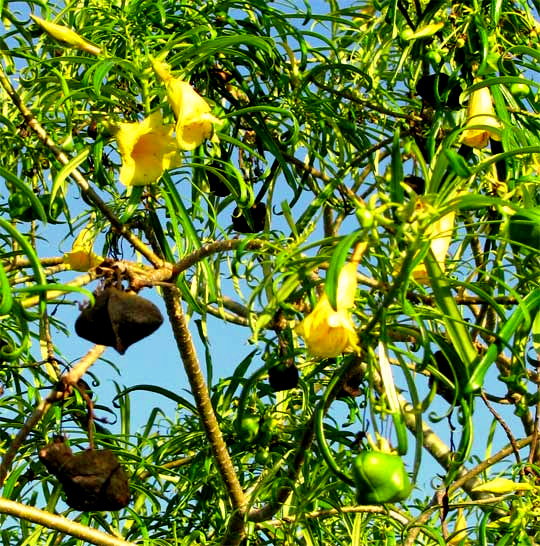 Yellow Oleander is a completely different species from the plant known as Oleander. The two bushes belong to the same family, the Dogbane Family, or Apocynaceae, but they reside in different genera. The Yellow Oleander is shown at the right.
Yellow Oleander is a completely different species from the plant known as Oleander. The two bushes belong to the same family, the Dogbane Family, or Apocynaceae, but they reside in different genera. The Yellow Oleander is shown at the right.
Flowers in the Dogbane Family are similar to our Standard Blossom" in that they bear a calyx with 5 sepals, and that there's just one female pistil, consisting of stigma, style and ovary. However, beyond that, things get interesting.
Instead of bearing five distinct petals, the corolla is like a slender funnel. The five stamens, instead of arising below the ovary as in our Standard Blossom, are inserted at the corolla's "throat," where the slender tube weakly begins to expand. And at this "throat" is where things get really interesting, as shown below:

Note the stigma's peculiar shape. It fits into the empty space in the corolla throat's center, in the picture between the two anthers designated by white arrows. At the picture's lower, right, you see what's in the exact center of the flower's throat, looking down on it from above. The five "star arms" are openings in the corolla closed with white, somewhat down-turned hairs. In other words, it's easier for something to enter the corolla chamber below the "throat" than to escape.
MK Adjaloo and others, writing in Genetics and Plant Physiology – 2015, Volume 5(2), pp. 145–161, mention bees and moths as pollinators of Yellow Oleander. GW Frankie and others, in the Journal of the Kansas Entomological Society, vol. 86, no. 4, 2013, pp. 325–351, writes that bee species who pollinate in the genus Thevetia are restricted to those with long tongues. Adjaloo's simple diagram of a Yellow Oleander flower indicates the location at the flower's nectaries at the throat, not at the corolla's base. If that's the case, in the picture, those glistening bumps below the anthers may be nectar-providing nectaries, enabling pollinators to take nectar without passing beyond the throat. But if that's so, how is pollen on an insect's tongue or proboscis withdrawn without being scraped off by the hairs?
However this obviously very specialized pollination system functions, it does a good job producing the numerous thick, four-sided, black, drupe-type fruits gracing the stems of the tree shown atop this page. Drupes are fleshy fruits that don't split open at maturity, with the fleshy part surrounding a single hardened shell, the "endocarp," which in turn covers a single seed. Other well known drupes include plums, cherries, and olives.
Yellow Oleander fruits are green when immature, then turn a bright, glossy red, and finally become dull black. The smooth, brown hard part inside often is called a "lucky nut," and may be strung on necklaces and sold as charms to be carried in the pocket. Some folks regard them as protection against the evil eye.